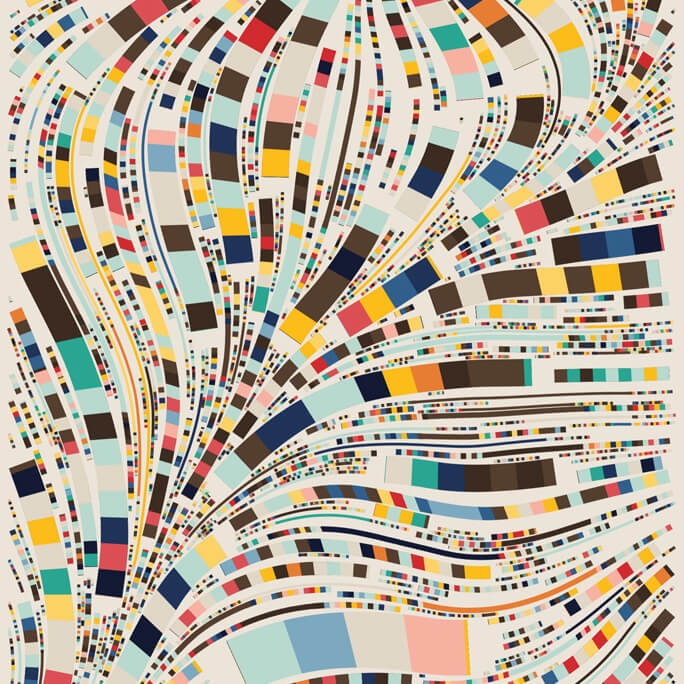Educational robotics: the robots are kids stuff
Schools are now introducing the basic principles of robotics to children at a very early age.
Artworks with blockchain certificates create a new market that is also fostering a unique community of native crypto artists
In this article, you will find out:
What is the common denominator of a meme from fifteen years ago, a clip of less than a minute of a singer and a collage covering five thousand days of an artist’s production? Well, three letters: NFT (non-fungible token). Or, in other words, the application of blockchain to the sale of art and digital property in general.
The meme we mentioned is the famous fire girl and fetched $500,000 at an auction this year. The clip of the singer belongs to Grimes, who auctioned it along with other artistic creations. And the collage is Everydays: the First 5000 Days by the artist Beeple, which broke all records and made him the highest-priced living artist. All of them were sold as NFTs.

In case you’re not up to speed, here’s a refresher. If you are acquainted with how blockchain technology works, you’ll know that it’s about blocks validated by a network of nodes that become part of a chain. This chain has a “memory” and stores all the operations performed. As it is decentralized, it is almost impossible to counterfeit.
Cryptocurrencies are one of the primary applications of blockchain, but each of them is interchangeable with another: a bitcoin is a currency with the same value and characteristics as another bitcoin. In other words, it is a fungible good. But NFTs are slightly different. By relying on Ethereum’s blockchain technology, a layer of data is added to its blocks, so that reference to an asset and its owner can be included. And therein lies the key to the boom in the art world.
In the case of blockchain applied to art, the owner of Beeple’s NFT is listed on its token and the characteristics of the acquired work. In other words, what was previously reproducible to infinity has now become a unique asset. Thus, the pillar of this ecosystem is a new type of digital property certificate that also prevents counterfeiting.
Then, the buyer can receive a specific digital version of the work, although it is not essential. In the case of Beeple’s collage, it is a high-resolution image weighing 319 GB that the buyer has exhibited in a gallery in the metaverse.
If you want to see the exhibit, there are also digital tickets for sale. The metaverse would require an article in its own right, but we’ll focus on blockchain and art for now.
Unlike Beeple’s artwork, the buyer of the meme we mentioned at the beginning got the exact image you see in your browser. The only nuance is that you are not the official owner, and they are.
So what happens when an NFT is sold? In Beeple’s case, the artist has not waived his or her copyright. Think of a publisher publishing a book, even though the authorship is the writer’s. Thus, each time a new sale of the NFT is made in the future, the author will receive a share of the revenue.
Considering these factors, it is understandable that the model has attracted the interest of auction houses, art galleries, and artists. Among the main advantages of NFTs in the art sector, we could summarize the following:

As noted above, classic auction houses such as Sotheby’s have been quick to jump on the bandwagon. However, the phenomenon is spawning new communities and specific marketplaces dedicated to the buying and selling of art NFTs. Some of the names that have emerged in the heat of the fever are Art Olin, Art Blocks, Async Art, BAE, CryptoArt.ai o EthBlock.art.
And not only that: platforms such as Art Blocks have specialized in specific artistic manifestations such as generative art based on algorithms. If you want to know what it’s about, you have an example at the end of the article.
The so-called crypto-art is in its early stages, but there are already numerous examples of its growing implementation and acceptance. Beeple is one of the pioneers, but multiple artists and even art galleries have followed suit with all kinds of initiatives.
The story of Beeple’s work, while making headlines, is considered the beginning and end of the NFT bubble. No one has ever again dropped close to seventy million dollars for a token of an artwork.
What is happening is that a new generation of artists, many of them teenagers such as Benyamin Ahmed, is beginning to capitalize on the potential of cryptocurrencies. Ahmed, at only twelve years old, is breaking price records.
Other new names on the scene are Jaiden Stipp and Victor Langlois. They are artists who enjoy repercussion in networks and are skipping the circuit of galleries, dealers, and auction houses that prevailed.
These artists upload their works to platforms such as SuperRare, where they “tokenize” and sell their work, dispensing with the cocktails and canapés part.

However, NFTs need not necessarily refer to digital artwork. A case in point is the initiative of the Russian Hermitage Museum. The renowned art museum has launched NFT versions of classic works by Leonardo da Vinci or Van Gogh. Naturally, the buyer does not keep the actual canvas but a token that, in this case, includes the signature of Mikhail Piotrovsky, the museum’s general director.
Another gallery that has joined the trend is the Uffizi Gallery in Florence. The gallery houses some of the immortal works of artists such as Botticelli, Caravaggio, and Michelangelo. In the case of the latter, an NFT of one of his paintings recently sold for $170,000. The sale was carried out to lessen the losses caused by the coronavirus pandemic.
This type of initiative has been dubbed “phygital” art, i.e. a mix of digital and physical. But, if you want to learn about the latest trends in purely digital art ownership (and generation), read on.
If the world of blockchain applied to art may seem baffling, you haven’t heard it all yet. The latest craze is NFTs applied to algorithmically generated art.
The author is responsible for defining the initial parameters, the elements to be combined, and the color ranges. Once this phase is completed, the algorithms recombine the elements and generate hundreds and sometimes thousands of combinations.
One of the most talked-about cases is the Bored Ape Yacht Club gallery of profile images (known as PFP) composed of ten thousand images. Sotheby’s auction house managed to sell a part of the collection, composed of a hundred boring monkeys, for 24.4 million dollars. And it seems that its competitor Christie’s is also interested in holding a similar auction.
Art Blocks' generative art platform also allows artists to upload their algorithms and generate limited series of works associated with the Ethereum blockchain. And here we come to a critical question. If NFTs have changed the concept of digital ownership of art, will generative algorithms also change the concept of artistic authorship?
Sources: The Verge, ArtNews, https://www.artnews.com/art-news/news/hermitage-museum-nfts-monet-leonardo-1234600031/
All fields are mandatory.
Read the most discussed articles
{{CommentsCount}} Comments
Currently no one has commented on the news.
Be the first to leave a comment.
{{firstLevelComment.Name}}
{{firstLevelComment.DaysAgo}} days ago
{{firstLevelComment.Text}}
Answer{{secondLevelComment.Name}}
{{secondLevelComment.DaysAgo}} days ago
{{secondLevelComment.Text}}